No Scaling Back for These Exams
From gathering physiological data such as body weight, complete blood counts and biochemistry profiles to conducting advanced diagnostic imaging such as radiographs (x-rays) or ultrasounds, every animal at the Zoo undergoes routine veterinary visits for wellness examinations. Just as the furred and feathered animals have routine wellness checks and exams, so do the slimy and scaly residents. The Zoo’s new veterinarian, Dr. Tara Reilly, has wasted no time getting to know the animals’ health, starting with an array of diagnostics in our reptilian critters.
Dermatology
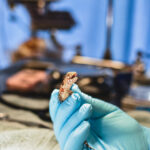 Dennis, the Zoo’s Lead Reptile Keeper, noticed a four-month-old Chinese crocodile lizard, weighing just over seven grams, had a couple of white spots on his tail and back. When Dr. Reilly had the chance to examine the lizard, it was if the spots had disappeared. Once the lizard was sprayed with water – they spend a majority of their time in water – the spots magically appeared, coining the nickname “color-changing Hot Wheels” for the lizard.
Dennis, the Zoo’s Lead Reptile Keeper, noticed a four-month-old Chinese crocodile lizard, weighing just over seven grams, had a couple of white spots on his tail and back. When Dr. Reilly had the chance to examine the lizard, it was if the spots had disappeared. Once the lizard was sprayed with water – they spend a majority of their time in water – the spots magically appeared, coining the nickname “color-changing Hot Wheels” for the lizard.
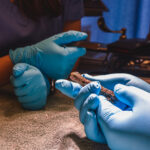 Dr. Reilly retrieved samples of the tissue, which was determined to be
Dr. Reilly retrieved samples of the tissue, which was determined to be as scar tissue. The lizard’s skin underneath the tissue was confirmed as being healthy and Keepers believe the lizard’s feisty and active personality contributed to the marks – he did try to nibble on fingers during his own exam! This lizard is back in his habitat at the World of Reptiles Nursery.
OUTGOING EXAMS
A pre-shipment exam occurs when an animal is examined prior to leaving the Zoo to transfer to another institution, often as part of a breeding recommendation from the animal’s Species Survival Plan (SSP for short) or social companionship. This exam ensures that the animal is healthy for travel and the information obtained during the exam is also beneficial for the receiving institution so they are aware of the animal’s demeanor, body weight, current diet, and previous medical history (if any) so that the animal can easily and smoothly transition to their new home.
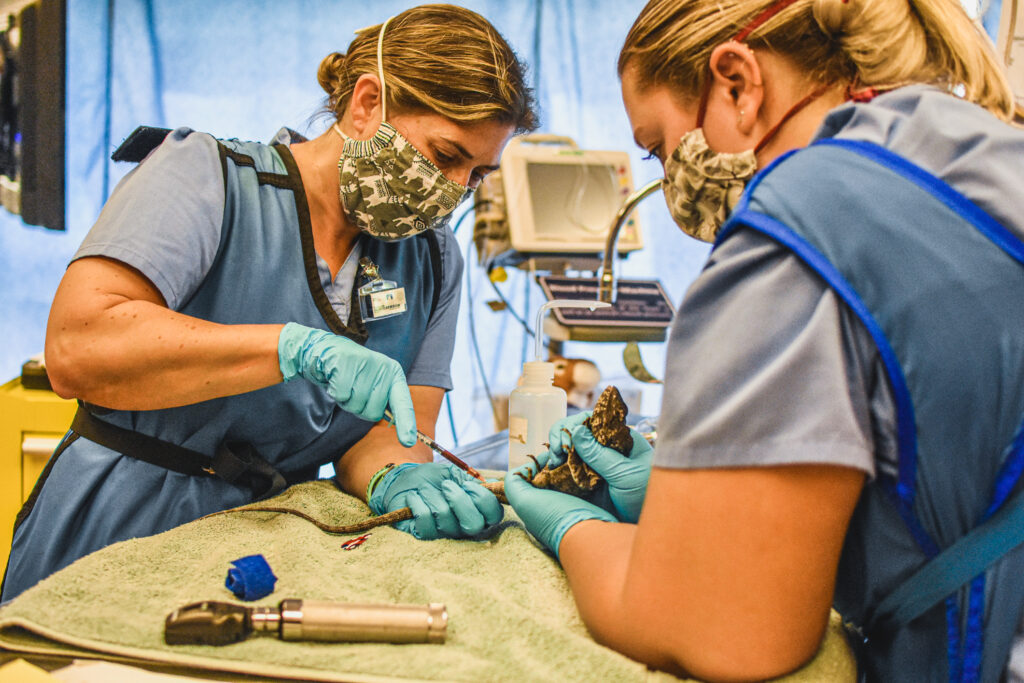
Recently, three frilled lizards visited Dr. Reilly for their pre-shipment exams. For each lizard, bloodwork was performed, body weight was recorded and a thorough body condition assessment was completed. Additionally, a systematic physical exam was performed to check the eyes, mouth, ears, skin, scales, legs, tail and frill. The frill is the flap of skin around the neck that is a prominent defense mechanism for these animals. Dr. Reilly took a thorough look through at these appendages, making sure there were no defects or ectoparasites (mites and ticks are sneaky and like to hide in these warm flaps of skin).
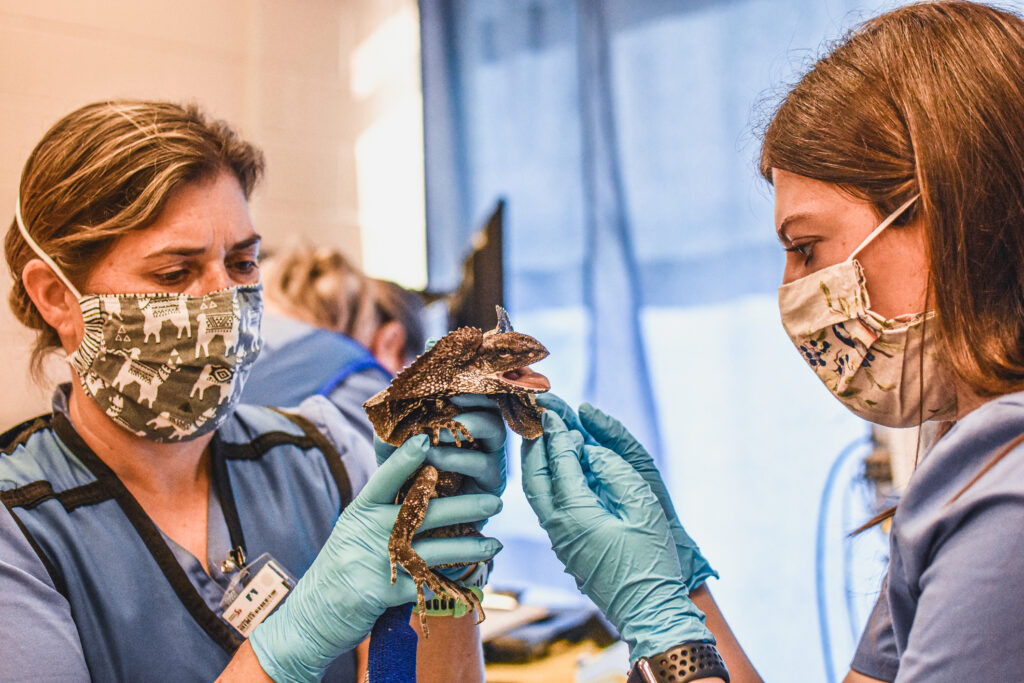
Vet staff also took x-rays, or radiographs, of each lizard. These animals are very feisty, so to keep them still during their radiographs, staff place miniature cotton balls over their eyelids and then wrap them lightly with vet wrap to hold the cotton balls in place (similar to a blindfold) to calm them down. This method makes the exam process easier for all parties involved and keeps the animals calm without needing to sedate or anesthetize the animal. During the radiographs, Dr. Reilly also utilized a foam pad for the lizards to grip onto and feel safe – like they are resting on a branch, which helps them to get quality radiographs and views of their body, limbs, toes and tail.
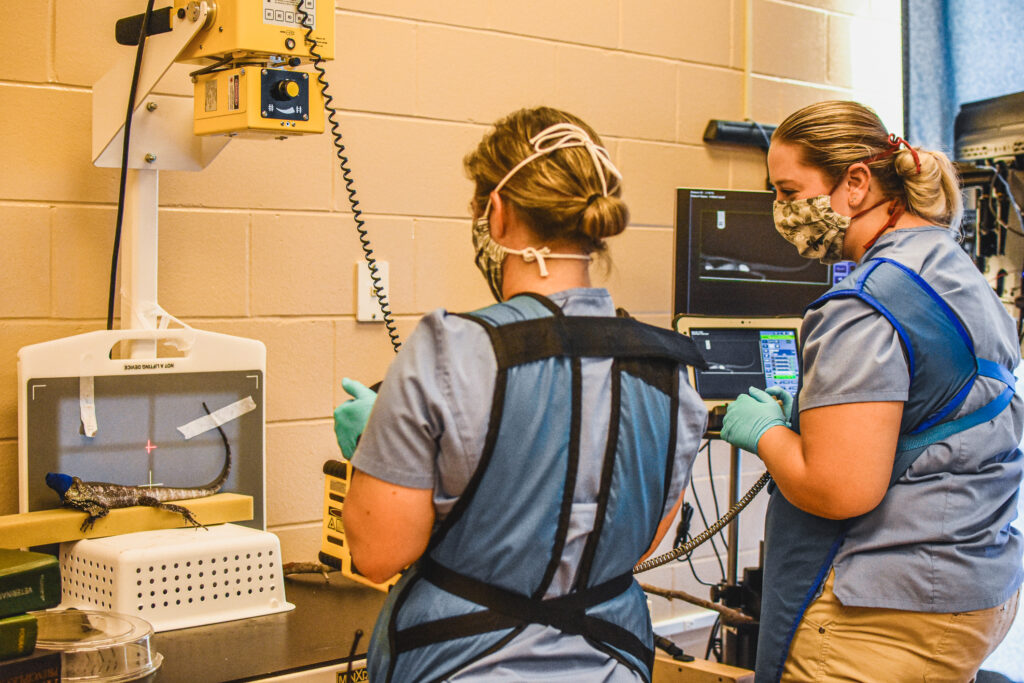
Overall, all three individuals were found to be physically healthy despite a couple of aesthetic imperfections, such as missing fingernails and small holes in their frills likely caused from roughhousing with siblings when younger. The trio are headed to their next home for new adventures!
NEW ARRIVAL EXAMINATION (INTAKE EXAMS)
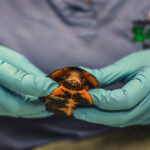 Once animals arrive safely at the Zoo, they spend their first few days in quarantine to adjust to their new surroundings and ensure they are healthy prior to going into their new exhibit. During their time in quarantine, each animal receives a thorough quarantine examination which involves baseline bloodwork, fecal examinations, recording body weight, assessing diet consumption, taking radiographs, and conducting a body condition assessment and systematic physical examination to check from their eyes to their toes – and everything in between. Dr. Tara finished her round of reptile exams with an inspection of two new Spotted turtles.
Once animals arrive safely at the Zoo, they spend their first few days in quarantine to adjust to their new surroundings and ensure they are healthy prior to going into their new exhibit. During their time in quarantine, each animal receives a thorough quarantine examination which involves baseline bloodwork, fecal examinations, recording body weight, assessing diet consumption, taking radiographs, and conducting a body condition assessment and systematic physical examination to check from their eyes to their toes – and everything in between. Dr. Tara finished her round of reptile exams with an inspection of two new Spotted turtles.
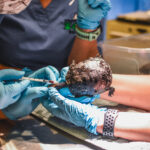 Dr. Tara compared the information given to her about the turtles pre-quarantine (on arrival during intake) and their current condition and noticed the turtles had gained weight, which is a good sign that they are healthy and have adjusted well to their new surroundings. Turtles will often not eat for a period of time when in new environments, so these findings were very encouraging for staff that these animals have adjusted very well to their new surroundings. The Zoo Vet also had her hands full for the rest of the exam, from obtaining radiographs with the hyperactive turtles to drawing blood from the shy turtles.
Dr. Tara compared the information given to her about the turtles pre-quarantine (on arrival during intake) and their current condition and noticed the turtles had gained weight, which is a good sign that they are healthy and have adjusted well to their new surroundings. Turtles will often not eat for a period of time when in new environments, so these findings were very encouraging for staff that these animals have adjusted very well to their new surroundings. The Zoo Vet also had her hands full for the rest of the exam, from obtaining radiographs with the hyperactive turtles to drawing blood from the shy turtles.
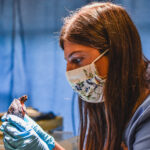 For radiographs (x-rays), the turtles are placed on a pedestal so that their legs hang down and they can relax and feel as though they are suspended in air. This helps vet staff to get good quality radiographs of awake turtles without needing to sedate or anesthetize them. The male was very active and made obtaining radiographs more challenging while the female was more relaxed and made everything very simple. The opposite occurred during bloodwork. The female was very shy, making it difficult to draw blood, which vet staff obtain from the jugular vein in the neck. For any other animal, this may seem like an easy task, but for an animal that can retract its head and neck back into their shell, the task becomes much more difficult. Unlike the shy female, the male turtle was more cooperative and quickly “came out of his shell” for an easier blood draw. Both turtles were deemed healthy and received the doctor’s approval to move into their new home.
For radiographs (x-rays), the turtles are placed on a pedestal so that their legs hang down and they can relax and feel as though they are suspended in air. This helps vet staff to get good quality radiographs of awake turtles without needing to sedate or anesthetize them. The male was very active and made obtaining radiographs more challenging while the female was more relaxed and made everything very simple. The opposite occurred during bloodwork. The female was very shy, making it difficult to draw blood, which vet staff obtain from the jugular vein in the neck. For any other animal, this may seem like an easy task, but for an animal that can retract its head and neck back into their shell, the task becomes much more difficult. Unlike the shy female, the male turtle was more cooperative and quickly “came out of his shell” for an easier blood draw. Both turtles were deemed healthy and received the doctor’s approval to move into their new home.
The pair are now in the World of Reptiles, which is currently temporarily closed, but Dr. Tara and Keepers are excited they are healthy and anticipate them doing well in their new exhibit.